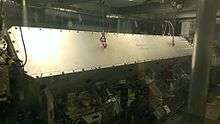Radio-frequency quadrupole
See also: Quadrupole mass analyzer and RFQ Beam Coolers
A radio-frequency quadrupole (RFQ) is a linear accelerator component[1] generally used at low beam energies, roughly 50keV to 3MeV. It is similar in concept to a quadrupole mass analyser but its purpose is to accelerate a single-species beam (rather than perform mass spectrometry on a multiple-species beam).

The Radio-frequency quadrupole from the reaccelerator (ReA3) at the National Superconducting Cyclotron Laboratory (NSCL) at Michigan State University.
The RFQ is a combined-function component that both accelerates and focuses the beam of charged particles.
Invented by Soviet physicists I. M. Kapchinsky and Vladimir Teplyakov in 1970, the RFQ is used as an injector by major laboratories and industries throughout the world for radiofrequency linear accelerators.[2]
References
- ↑ "The ISIS neutron source RFQ" (PDF).
- ↑ Reiser, Martin (2008). Theory and design of charged particle beams (2nd ed.). Weinheim: Wiley-VCH. p. 6. ISBN 9783527407415.
External links
This article is issued from Wikipedia - version of the 10/31/2016. The text is available under the Creative Commons Attribution/Share Alike but additional terms may apply for the media files.